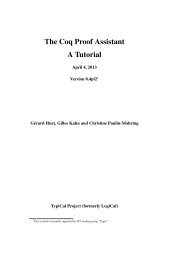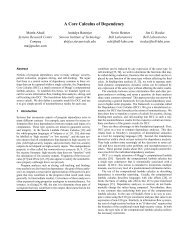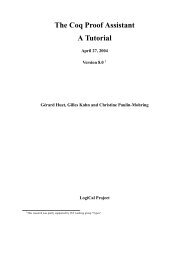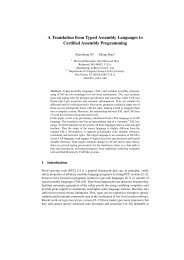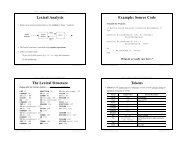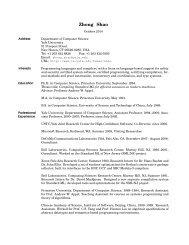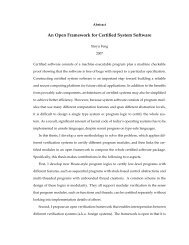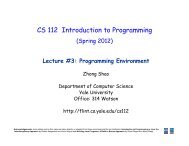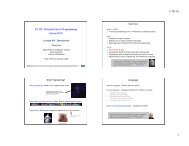Lexical Analysis Example: Source Code The ... - Yale University
Lexical Analysis Example: Source Code The ... - Yale University
Lexical Analysis Example: Source Code The ... - Yale University
Create successful ePaper yourself
Turn your PDF publications into a flip-book with our unique Google optimized e-Paper software.
C S 4 2 1 C O M P I L E R S A N D I N T E R P R E T E R S<br />
C S 4 2 1 C O M P I L E R S A N D I N T E R P R E T E R S<br />
<strong>Lexical</strong> <strong>Analysis</strong><br />
• Read source program and produce a list of tokens (“linear” analysis)<br />
source<br />
program<br />
• <strong>The</strong> lexical structure is specified using regular expressions<br />
• Other secondary tasks:<br />
(1) get rid of white spaces (e.g., \t,\n,\sp) and comments<br />
(2) line numbering<br />
lexical<br />
analyzer<br />
token<br />
get next<br />
token<br />
parser<br />
<strong>Example</strong>: <strong>Source</strong> <strong>Code</strong><br />
A Sample Toy Program:<br />
(* define valid mutually recursive procedures *)<br />
let<br />
function do_nothing1(a: int, b: string)=<br />
do_nothing2(a+1)<br />
function do_nothing2(d: int) =<br />
do_nothing1(d, “str”)<br />
in<br />
end<br />
do_nothing1(0, “str2”)<br />
What do we really care here <br />
Copyright 1994 - 2010 Zhong Shao, <strong>Yale</strong> <strong>University</strong> <strong>Lexical</strong> <strong>Analysis</strong> : Page 1 of 40<br />
Copyright 1994 - 2010 Zhong Shao, <strong>Yale</strong> <strong>University</strong> <strong>Lexical</strong> <strong>Analysis</strong> : Page 2 of 40<br />
C S 4 2 1 C O M P I L E R S A N D I N T E R P R E T E R S<br />
C S 4 2 1 C O M P I L E R S A N D I N T E R P R E T E R S<br />
<strong>The</strong> <strong>Lexical</strong> Structure<br />
Output after the <strong>Lexical</strong> <strong>Analysis</strong> ----- token + associated value<br />
LET 51 FUNCTION 56 ID(do_nothing1) 65<br />
LPAREN 76 ID(a) 77 COLON 78<br />
ID(int) 80 COMMA 83 ID(b) 85<br />
COLON 86 ID(string) 88 RPAREN 94<br />
EQ 95 ID(do_nothing2) 99<br />
LPAREN 110 ID(a) 111 PLUS 112<br />
INT(1) 113 RPAREN 114 FUNCTION 117<br />
ID(do_nothing2) 126 LPAREN 137<br />
ID(d) 138 COLON 139 ID(int) 141<br />
RPAREN 144 EQ 146<br />
ID(do_nothing1) 150 LPAREN 161<br />
ID(d) 162 COMMA 163 STRING(str) 165<br />
RPAREN 170 IN 173<br />
ID(do_nothing1) 177 LPAREN 188<br />
INT(0) 189 COMMA 190 STRING(str2) 192<br />
RPAREN 198 END 200 EOF 203<br />
Tokens<br />
• Tokens are the atomic unit of a language, and are usually specific<br />
strings or instances of classes of strings.<br />
Tokens Sample Values Informal Description<br />
LET let keyword LET<br />
END end keyword END<br />
PLUS +<br />
LPAREN (<br />
COLON :<br />
STRING<br />
“str”<br />
RPAREN )<br />
INT 49, 48 integer constants<br />
ID do_nothing1, a,<br />
int, string<br />
EQ =<br />
EOF<br />
letter followed by letters, digits, and<br />
under-scores<br />
end of file<br />
Copyright 1994 - 2010 Zhong Shao, <strong>Yale</strong> <strong>University</strong> <strong>Lexical</strong> <strong>Analysis</strong> : Page 3 of 40<br />
Copyright 1994 - 2010 Zhong Shao, <strong>Yale</strong> <strong>University</strong> <strong>Lexical</strong> <strong>Analysis</strong> : Page 4 of 40
C S 4 2 1 C O M P I L E R S A N D I N T E R P R E T E R S<br />
<strong>Lexical</strong> <strong>Analysis</strong>, How<br />
• First, write down the lexical specification (how each token is defined)<br />
using regular expression to specify the lexical structure:<br />
identifier = letter (letter | digit | underscore) *<br />
letter = a | ... | z | A | ... | Z<br />
digit = 0 | 1 | ... | 9<br />
• Second, based on the above lexical specification, build the lexical<br />
analyzer (to recognize tokens) by hand,<br />
Regular Expression Spec ==> NFA ==> DFA ==>Transition Table ==> <strong>Lexical</strong> Analyzer<br />
• Or just by using lex --- the lexical analyzer generator<br />
Regular Expression Spec (in lex format) ==> feed to lex ==> <strong>Lexical</strong> Analyzer<br />
C S 4 2 1 C O M P I L E R S A N D I N T E R P R E T E R S<br />
Regular Expressions<br />
• regular expressions are concise, linguistic characterization of regular<br />
languages (regular sets)<br />
identifier = letter (letter | digit | underscore) *<br />
“or”<br />
• each regular expression define a regular language --- a set of strings<br />
over some alphabet, such as ASCII characters; each member of this set<br />
is called a sentence, or a word<br />
• we use regular expressions to define each category of tokens<br />
“ 0 or more”<br />
For example, the above identifier specifies a set of strings that<br />
are a sequence of letters, digits, and underscores, starting with a letter.<br />
Copyright 1994 - 2010 Zhong Shao, <strong>Yale</strong> <strong>University</strong> <strong>Lexical</strong> <strong>Analysis</strong> : Page 5 of 40<br />
Copyright 1994 - 2010 Zhong Shao, <strong>Yale</strong> <strong>University</strong> <strong>Lexical</strong> <strong>Analysis</strong> : Page 6 of 40<br />
C S 4 2 1 C O M P I L E R S A N D I N T E R P R E T E R S<br />
C S 4 2 1 C O M P I L E R S A N D I N T E R P R E T E R S<br />
<strong>Example</strong><br />
Regular Expression<br />
a *<br />
a +<br />
a) denotes ,the empty string, denotes the language { }.<br />
b) for each a in , a denotes { a } --- a language with one string.<br />
[a-zA-Z]<br />
c) if R denotes L R and S denotes L S then R | S denotes the language<br />
L R L S , i.e, { x | x L R or x L S }.<br />
d) if R denotes L R and S denotes L S then RS denotes the language<br />
(ab|aab|b) * (a|aa|e) <br />
L R L S , that is, { xy | x L R and y L S }.<br />
e) if R denotes L R then R * denotes the language L * R where L * is the<br />
union of all L i (i=0,...,and L i is just {x 1 x 2 ...x i | x 1 L, ..., x i L}.<br />
Regular Expressions and Regular<br />
Languages<br />
• Given an alphabet the regular expressions over and their<br />
corresponding regular languages are<br />
Explanation<br />
0 or more a’s<br />
1 or more a’s<br />
(a|b) * all strings of a’s and b’s (including )<br />
(aa|ab|ba|bb) * all strings of a’s and b’s of even length<br />
shorthand for “a|b|...|z|A|...|Z”<br />
[0-9] shorthand for “0|1|2|...|9”<br />
0([0-9]) * 0 numbers that start and end with 0<br />
all strings that contain foo as substring<br />
• the following is not a regular expression: a n b n (n > 0)<br />
Copyright 1994 - 2010 Zhong Shao, <strong>Yale</strong> <strong>University</strong> <strong>Lexical</strong> <strong>Analysis</strong> : Page 7 of 40<br />
Copyright 1994 - 2010 Zhong Shao, <strong>Yale</strong> <strong>University</strong> <strong>Lexical</strong> <strong>Analysis</strong> : Page 8 of 40
C S 4 2 1 C O M P I L E R S A N D I N T E R P R E T E R S<br />
<strong>Lexical</strong> Specification<br />
• Using regular expressions to specify tokens<br />
keyword = begin | end | if | then | else<br />
identifier = letter (letter | digit | underscore) *<br />
integer = digit +<br />
relop = < | | >=<br />
letter = a | b | ... | z | A | B | ... | Z<br />
digit = 0 | 1 | 2 | ... | 9<br />
• Ambiguity : is “begin” a keyword or an identifier <br />
• Next step: to construct a token recognizer for languages given by<br />
regular expressions --- by using finite automata !<br />
given a string x, the token recognizer says “yes” if x is a sentence of<br />
the specified language and says “no” otherwise<br />
C S 4 2 1 C O M P I L E R S A N D I N T E R P R E T E R S<br />
Transition Diagrams<br />
• Flowchart with states and edges; each edge is labelled with characters;<br />
certain subset of states are marked as “final states”<br />
• Transition from state to state proceeds along edges according to the next<br />
input character<br />
letter digit underscore<br />
start letter delimiter<br />
0 1 2<br />
• Every string that ends up at a final state is accepted<br />
final state<br />
• If get “stuck”, there is no transition for a given character, it is an error<br />
• Transition diagrams can be easily translated to programs using case<br />
statements (in C).<br />
Copyright 1994 - 2010 Zhong Shao, <strong>Yale</strong> <strong>University</strong> <strong>Lexical</strong> <strong>Analysis</strong> : Page 9 of 40<br />
Copyright 1994 - 2010 Zhong Shao, <strong>Yale</strong> <strong>University</strong> <strong>Lexical</strong> <strong>Analysis</strong> : Page 10 of 40<br />
C S 4 2 1 C O M P I L E R S A N D I N T E R P R E T E R S<br />
Transition Diagrams (cont’d)<br />
<strong>The</strong> token recognizer (for identifiers) based on transition diagrams:<br />
state0:<br />
state1:<br />
c = getchar();<br />
if (isalpha(c)) goto state1;<br />
error();<br />
...<br />
c = getchar();<br />
if (isalpha(c) || isdigit(c) ||<br />
isunderscore(c)) goto state1;<br />
if (c == ‘,’ || ... || c == ‘)’) goto state2;<br />
error();<br />
...<br />
state2: ungetc(c,stdin); /* retract current char */<br />
return(ID, ... the current identifier ...);<br />
Next: 1. finite automata are generalized transition diagrams !<br />
2. how to build finite automata from regular expressions<br />
C S 4 2 1 C O M P I L E R S A N D I N T E R P R E T E R S<br />
Finite Automata<br />
• Finite Automata are similar to transition diagrams; they have states and<br />
labelled edges; there are one unique start state and one or more than<br />
one final states<br />
• Nondeterministic Finite Automata (NFA) :<br />
a) can label edges (these edges are called -transitions)<br />
b) some character can label 2 or more edges out of the same state<br />
• Deterministic Finite Automata (DFA) :<br />
a) no edges are labelled with <br />
b) each charcter can label at most one edge out of the same state<br />
• NFA and DFA accepts string x if there exists a path from the start state<br />
to a final state labeled with characters in x<br />
NFA: multiple paths<br />
DFA: one unique path<br />
Copyright 1994 - 2010 Zhong Shao, <strong>Yale</strong> <strong>University</strong> <strong>Lexical</strong> <strong>Analysis</strong> : Page 11 of 40<br />
Copyright 1994 - 2010 Zhong Shao, <strong>Yale</strong> <strong>University</strong> <strong>Lexical</strong> <strong>Analysis</strong> : Page 12 of 40
C S 4 2 1 C O M P I L E R S A N D I N T E R P R E T E R S<br />
C S 4 2 1 C O M P I L E R S A N D I N T E R P R E T E R S<br />
<strong>Example</strong>: NFA<br />
<strong>Example</strong>: DFA<br />
start<br />
state<br />
start<br />
a<br />
final state<br />
0 1 2<br />
3<br />
a<br />
b<br />
An NFA accepts (a|b) * abb<br />
b<br />
b<br />
start<br />
state<br />
start<br />
b<br />
b<br />
final state<br />
a<br />
b<br />
0 1 2<br />
3<br />
a<br />
a<br />
A DFA accepts (a|b) * abb<br />
b<br />
a<br />
<strong>The</strong>re are many possible moves --- to accept a string, we only need one<br />
sequence of moves that lead to a final state.<br />
<strong>The</strong>re is only one possible sequence of moves --- either lead to a final<br />
state and accept or the input string is rejected<br />
input string: aabb<br />
One sucessful sequence: 0 0 1 2 3<br />
Another unsuccessful sequence:<br />
a<br />
a<br />
a<br />
a<br />
0 0 0 0 0<br />
b<br />
b<br />
b<br />
b<br />
input string:<br />
aabb<br />
<strong>The</strong> sucessful sequence:<br />
a<br />
a<br />
0 1 1 2 3<br />
b<br />
b<br />
Copyright 1994 - 2010 Zhong Shao, <strong>Yale</strong> <strong>University</strong> <strong>Lexical</strong> <strong>Analysis</strong> : Page 13 of 40<br />
Copyright 1994 - 2010 Zhong Shao, <strong>Yale</strong> <strong>University</strong> <strong>Lexical</strong> <strong>Analysis</strong> : Page 14 of 40<br />
C S 4 2 1 C O M P I L E R S A N D I N T E R P R E T E R S<br />
Transition Table<br />
• Finite Automata can also be represented using transition tables<br />
C S 4 2 1 C O M P I L E R S A N D I N T E R P R E T E R S<br />
NFA with -transitions<br />
1. NFA can have -transitions --- edges labelled with <br />
For NFA, each entry is a set of<br />
states:<br />
STATE a b<br />
0 {0,1} {0}<br />
1 - {2}<br />
2 - {3}<br />
3 - -<br />
For DFA, each entry is a unique<br />
state:<br />
STATE a b<br />
0 1 0<br />
1 1 2<br />
2 1 3<br />
3 1 0<br />
0<br />
<br />
<br />
1<br />
3<br />
a<br />
b<br />
2<br />
4<br />
a<br />
b<br />
accepts the regular language denoted by (aa * |bb * )<br />
Copyright 1994 - 2010 Zhong Shao, <strong>Yale</strong> <strong>University</strong> <strong>Lexical</strong> <strong>Analysis</strong> : Page 15 of 40<br />
Copyright 1994 - 2010 Zhong Shao, <strong>Yale</strong> <strong>University</strong> <strong>Lexical</strong> <strong>Analysis</strong> : Page 16 of 40
C S 4 2 1 C O M P I L E R S A N D I N T E R P R E T E R S<br />
Regular Expressions -> NFA<br />
• How to construct NFA (with -transitions) from a regular expression <br />
• Algorithm : apply the following construction rules , use unique names<br />
for all the states. (inportant invariant: always one final state !)<br />
1. Basic Construction<br />
• <br />
• a <br />
i<br />
i<br />
<br />
a<br />
f<br />
f<br />
2. “Inductive” Construction<br />
• R 1 | R 2<br />
C S 4 2 1 C O M P I L E R S A N D I N T E R P R E T E R S<br />
RE -> NFA (cont’d)<br />
N 1<br />
i <br />
N 2<br />
initial state<br />
for N 1 and N 2<br />
• R 1 R 2<br />
<br />
merge : final state of N 1<br />
and initial state of N 2<br />
N 1 : NFA for R 1<br />
N 2 : NFA for R 2<br />
<br />
f<br />
<br />
the new and<br />
unique final state<br />
final state<br />
for N 1 and N 2<br />
initial state<br />
for N 1<br />
N 1 N 2<br />
final state<br />
for N 2<br />
Copyright 1994 - 2010 Zhong Shao, <strong>Yale</strong> <strong>University</strong> <strong>Lexical</strong> <strong>Analysis</strong> : Page 17 of 40<br />
Copyright 1994 - 2010 Zhong Shao, <strong>Yale</strong> <strong>University</strong> <strong>Lexical</strong> <strong>Analysis</strong> : Page 18 of 40<br />
C S 4 2 1 C O M P I L E R S A N D I N T E R P R E T E R S<br />
RE -> NFA (cont’d)<br />
2. “Inductive” Construction (cont’d)<br />
C S 4 2 1 C O M P I L E R S A N D I N T E R P R E T E R S<br />
<strong>Example</strong> : RE -> NFA<br />
Converting the regular expression : (a|b) * abb<br />
a (in a|b)===><br />
2<br />
a<br />
3<br />
• R 1<br />
*<br />
initial state<br />
for N 1<br />
final state<br />
for N 1<br />
N 1 : NFA for R 1<br />
b (in a|b)===><br />
4<br />
b<br />
5<br />
<br />
<br />
i N 1<br />
<br />
<br />
f<br />
a|b ====><br />
1<br />
<br />
<br />
2<br />
4<br />
a<br />
b<br />
3<br />
5<br />
<br />
<br />
6<br />
Copyright 1994 - 2010 Zhong Shao, <strong>Yale</strong> <strong>University</strong> <strong>Lexical</strong> <strong>Analysis</strong> : Page 19 of 40<br />
Copyright 1994 - 2010 Zhong Shao, <strong>Yale</strong> <strong>University</strong> <strong>Lexical</strong> <strong>Analysis</strong> : Page 20 of 40
C S 4 2 1 C O M P I L E R S A N D I N T E R P R E T E R S<br />
<strong>Example</strong> : RE -> NFA (cont’d)<br />
Converting the regular expression : (a|b) * abb<br />
C S 4 2 1 C O M P I L E R S A N D I N T E R P R E T E R S<br />
<strong>Example</strong> : RE -> NFA (cont’d)<br />
Converting the regular expression : (a|b) * abb<br />
(a|b) * ====><br />
<br />
(a|b) * abb ====><br />
<br />
<br />
<br />
2<br />
0 1<br />
6<br />
<br />
4<br />
a<br />
b<br />
<br />
3<br />
5<br />
<br />
<br />
<br />
7<br />
<br />
<br />
2<br />
0 1<br />
6<br />
<br />
4<br />
a<br />
b<br />
<br />
3<br />
5<br />
<br />
<br />
<br />
7<br />
abb<br />
X<br />
====> (several steps are omitted)<br />
a<br />
8<br />
b<br />
9<br />
b<br />
10<br />
a<br />
8<br />
b<br />
9<br />
b<br />
10<br />
Copyright 1994 - 2010 Zhong Shao, <strong>Yale</strong> <strong>University</strong> <strong>Lexical</strong> <strong>Analysis</strong> : Page 21 of 40<br />
Copyright 1994 - 2010 Zhong Shao, <strong>Yale</strong> <strong>University</strong> <strong>Lexical</strong> <strong>Analysis</strong> : Page 22 of 40<br />
C S 4 2 1 C O M P I L E R S A N D I N T E R P R E T E R S<br />
NFA -> DFA<br />
• NFA are non-deterministic; need DFA in order to write a deterministic<br />
prorgam !<br />
• <strong>The</strong>re exists an algorithm (“subset construction”) to convert any NFA to a<br />
DFA that accepts the same language<br />
• States in DFA are sets of states from NFA; DFA simulates “in parallel”<br />
all possible moves of NFA on given input.<br />
• Definition: for each state s in NFA,<br />
-CLOSURE(s) = { s } { t | s can reach t via -transitions }<br />
• Definition: for each set of states S in NFA,<br />
-CLOSURE(S) = i -CLOSURE(s) for all s i in S<br />
C S 4 2 1 C O M P I L E R S A N D I N T E R P R E T E R S<br />
NFA -> DFA (cont’d)<br />
• each DFA-state is a set of NFA-states<br />
• suppose the start state of the NFA is s, then the start state for its DFA<br />
is -CLOSURE(s) ; the final states of the DFA are those that include a<br />
NFA-final-state<br />
• Algorithm : converting an NFA N into a DFA D ----<br />
Dstates = {e-CLOSURE(s 0 ),s 0 is N’s start state}<br />
Dstates are initially “unmarked”<br />
while there is an unmarked D-state X do {<br />
mark X<br />
for each a in S do {<br />
T = {states reached from any s i in X via a}<br />
Y = e-CLOSURE(T)<br />
if Y not in Dstates then add Y to Dstates “unmarked”<br />
add transition from X to Y, labelled with a<br />
}<br />
}<br />
Copyright 1994 - 2010 Zhong Shao, <strong>Yale</strong> <strong>University</strong> <strong>Lexical</strong> <strong>Analysis</strong> : Page 23 of 40<br />
Copyright 1994 - 2010 Zhong Shao, <strong>Yale</strong> <strong>University</strong> <strong>Lexical</strong> <strong>Analysis</strong> : Page 24 of 40
C S 4 2 1 C O M P I L E R S A N D I N T E R P R E T E R S<br />
C S 4 2 1 C O M P I L E R S A N D I N T E R P R E T E R S<br />
<strong>Example</strong> : NFA -> DFA<br />
• converting NFA for (a|b)*abb to a DFA -------------<br />
<strong>The</strong> start state A = -CLOSURE(0) = {0, 1, 2, 4, 7}; Dstates={A}<br />
1st iteration: A is unmarked; mark A now;<br />
a-transitions: T = {3, 8}<br />
a new state B= -CLOSURE(3) -CLOSURE(8)<br />
= {3, 6, 1, 2, 4, 7} 8) = {1, 2, 3, 4, 6, 7, 8}<br />
add a transition from A to B labelled with a<br />
b-transitions: T = {5}<br />
a new state C = -CLOSURE(5) = {1, 2, 4, 5, 6, 7}<br />
add a transition from A to C labelled with b<br />
Dstates = {A, B, C}<br />
2nd iteration: B, C are unmarked; we pick B and mark B first;<br />
B = {1, 2, 3, 4, 6, 7, 8}<br />
B’s a-transitions: T = {3, 8}; T’s -CLOSURE is B itself.<br />
add a transition from B to B labelled with a<br />
<strong>Example</strong> : NFA -> DFA (cont’d)<br />
B’s b-transitions: T = {5, 9};<br />
a new state D = -CLOSURE({5, 9}) = {1, 2, 4, 5, 6, 7, 9}<br />
add a transition from B to D labelled with b<br />
Dstates = {A, B, C, D}<br />
then we pick C, and mark C<br />
C’s a-transitions: T = {3, 8}; its -CLOSURE is B.<br />
add a transition from C to B labelled with a<br />
C’s b-transitions: T = {5}; its -CLOSURE is C itself.<br />
add a transition from C to C labelled with b<br />
next we pick D, and mark D<br />
D’s a-transitions: T = {3, 8}; its -CLOSURE is B.<br />
add a transition from D to B labelled with a<br />
D’s b-transitions: T = {5, 10};<br />
a new state E = -CLOSURE({5, 10}) = {1, 2, 4, 5, 6, 7, 10}<br />
Dstates = {A, B, C, D, E}; E is a final state since it has 10;<br />
next we pick E, and mark E<br />
Copyright 1994 - 2010 Zhong Shao, <strong>Yale</strong> <strong>University</strong> <strong>Lexical</strong> <strong>Analysis</strong> : Page 25 of 40<br />
Copyright 1994 - 2010 Zhong Shao, <strong>Yale</strong> <strong>University</strong> <strong>Lexical</strong> <strong>Analysis</strong> : Page 26 of 40<br />
C S 4 2 1 C O M P I L E R S A N D I N T E R P R E T E R S<br />
C S 4 2 1 C O M P I L E R S A N D I N T E R P R E T E R S<br />
<strong>Example</strong> : NFA -> DFA (cont’d)<br />
E’s a-transitions: T = {3, 8}; its -CLOSURE is B.<br />
add a transition from E to B labelled with a<br />
E’s b-transitions: T = {5}; its -CLOSURE is C itself.<br />
add a transition from E to C labelled with b<br />
all states in Dstates are marked, the DFA is constructed !<br />
A<br />
a<br />
b<br />
a<br />
B<br />
a<br />
b<br />
C<br />
a<br />
D<br />
a<br />
b<br />
b<br />
E<br />
Other Algorithms<br />
• How to minimize a DFA (see Dragon Book 3.9, pp141)<br />
• How to convert RE to DFA directly (see Dragon Book 3.9, pp135)<br />
• How to prove two Regular Expressions are equivalent (see<br />
Dragon Book pp150, Exercise 3.22)<br />
b<br />
Copyright 1994 - 2010 Zhong Shao, <strong>Yale</strong> <strong>University</strong> <strong>Lexical</strong> <strong>Analysis</strong> : Page 27 of 40<br />
Copyright 1994 - 2010 Zhong Shao, <strong>Yale</strong> <strong>University</strong> <strong>Lexical</strong> <strong>Analysis</strong> : Page 28 of 40
C S 4 2 1 C O M P I L E R S A N D I N T E R P R E T E R S<br />
Lex<br />
• Lex is a program generator ---------- it takes lexical specification as<br />
input, and produces a lexical processor written in C.<br />
DIGITS [0-9]<br />
......<br />
C S 4 2 1 C O M P I L E R S A N D I N T E R P R E T E R S<br />
Lex Specification<br />
lex definition<br />
Lex<br />
Specification<br />
foo.l<br />
Lex<br />
lex.yy.c<br />
%%<br />
expression action<br />
integer printf(“INT”);<br />
translation rules<br />
lex.yy.c<br />
input text<br />
C Compiler<br />
a.out<br />
a.out<br />
sequence of tokens<br />
......<br />
%%<br />
.....<br />
char getc() { ......<br />
}<br />
user’s C functions<br />
(optional)<br />
• Implementation of Lex:<br />
Lex Spec -> NFA -> DFA -> Transition Tables + Actions -> yylex()<br />
• expression is a regular expression ; action is a piece of C program;<br />
• for details, read the Lesk&Schmidt paper<br />
Copyright 1994 - 2010 Zhong Shao, <strong>Yale</strong> <strong>University</strong> <strong>Lexical</strong> <strong>Analysis</strong> : Page 29 of 40<br />
Copyright 1994 - 2010 Zhong Shao, <strong>Yale</strong> <strong>University</strong> <strong>Lexical</strong> <strong>Analysis</strong> : Page 30 of 40<br />
C S 4 2 1 C O M P I L E R S A N D I N T E R P R E T E R S<br />
ML-Lex<br />
• ML-Lex is like Lex ---------- it takes lexical specification as input, and<br />
produces a lexical processor written in Standard ML.<br />
Lex<br />
Specification<br />
foo.lex<br />
foo.lex.sml<br />
input text<br />
ML-Lex<br />
ML Compiler<br />
Mlex<br />
foo.lex.sml<br />
module Mlex<br />
sequence of tokens<br />
• Implementation of ML-Lex is similar to implementation of Lex<br />
C S 4 2 1 C O M P I L E R S A N D I N T E R P R E T E R S<br />
ML-Lex Specification<br />
type pos = int<br />
val lineNum = ...<br />
val lexresult = ....<br />
....<br />
%%<br />
%s COMMENT STRING;<br />
SPACE=[ \t\n\012];<br />
DIGITS=[0-9];<br />
.....<br />
%%<br />
expression => (action);<br />
integer => (print(“INT”));<br />
...... => (...lineNum...);<br />
user’s ML<br />
declarations<br />
ml-lex definitions<br />
translation rules<br />
can call the above<br />
ML declarations<br />
• expression is a regular expression ; action is a piece of ML program;<br />
when the input matches the expression, the action is executed, the<br />
text matched is placed in the variable yytext.<br />
Copyright 1994 - 2010 Zhong Shao, <strong>Yale</strong> <strong>University</strong> <strong>Lexical</strong> <strong>Analysis</strong> : Page 31 of 40<br />
Copyright 1994 - 2010 Zhong Shao, <strong>Yale</strong> <strong>University</strong> <strong>Lexical</strong> <strong>Analysis</strong> : Page 32 of 40
C S 4 2 1 C O M P I L E R S A N D I N T E R P R E T E R S<br />
What does ML-Lex generate<br />
foo.lex<br />
ML-Lex<br />
foo.lex.sml<br />
sample foo.lex.sml:<br />
everything in part 1 of foo.lex<br />
structure Mlex =<br />
struct<br />
structure UserDeclarations = struct ... end<br />
......<br />
fun makeLexer yyinput = ....<br />
end<br />
To use the generated lexical processor:<br />
val lexer =<br />
Mlex.makeLexer(fn _ => input (openIn “toy”));<br />
val nextToken = lexer()<br />
each call returns one token !<br />
input filename<br />
C S 4 2 1 C O M P I L E R S A N D I N T E R P R E T E R S<br />
ML-Lex Definitions<br />
• Things you can write inside the “ml-lex definitions” section (2nd part):<br />
%s COMMENT STRING define new start states<br />
%reject<br />
%count<br />
%structure {identifier}<br />
REJECT() to reject a match<br />
count the line number<br />
the resulting structure name<br />
(the default is Mlex)<br />
(hint: you probably don’t need use %reject, %count,or %structure<br />
for assignment 2.)<br />
Definition of named regular expressions :<br />
identifier = regular expression<br />
SPACE=[ \t\n\012]<br />
IDCHAR=[_a-zA-Z0-9]<br />
Copyright 1994 - 2010 Zhong Shao, <strong>Yale</strong> <strong>University</strong> <strong>Lexical</strong> <strong>Analysis</strong> : Page 33 of 40<br />
Copyright 1994 - 2010 Zhong Shao, <strong>Yale</strong> <strong>University</strong> <strong>Lexical</strong> <strong>Analysis</strong> : Page 34 of 40<br />
C S 4 2 1 C O M P I L E R S A N D I N T E R P R E T E R S<br />
ML-Lex Translation Rules<br />
• Each translation rule (3rd part) are in the form<br />
regular expression => (action);<br />
• Valid ML-Lex regular expressions: (see ML-Lex-manual pp 4-6)<br />
a character stands for itself except for the reserved chars:<br />
* + | ( ) ^ $ / ; . = < > [ { ” \<br />
to use these chars, use backslash! for example, \\\” represents<br />
the string \”<br />
using square brackets to enclose a set of characters<br />
( \ - ^ are reserved)<br />
[abc]<br />
char a, or b, or c<br />
[^abc] all chars except a, b, c<br />
[a-z] all chars from a to z<br />
[\n\t\b] new line, tab, or backspace<br />
[-abc] char - or a or b or c<br />
C S 4 2 1 C O M P I L E R S A N D I N T E R P R E T E R S<br />
ML-Lex Translation Rules (cont’d)<br />
• Valid ML-Lex regular expressions: (cont’d)<br />
escape sequences: (can be used inside or outside square brackets)<br />
\b backspace<br />
\n newline<br />
\t tab<br />
\ddd any ascii char (ddd is 3 digit decimal)<br />
. any char except newline (equivalent to [^\n])<br />
“x” match string x exactly even if it contains reserved chars<br />
x an optional x<br />
x* 0 or more x’s<br />
x+ 1 or more x’s<br />
x|y x or y<br />
^x if at the beginning, match at the beginning of a line only<br />
{x} substitute definition x (defined in the lex definition section)<br />
(x) same as regular expression x<br />
x{n} repeating x for n times<br />
x{m-n} repeating x from m to n times<br />
Copyright 1994 - 2010 Zhong Shao, <strong>Yale</strong> <strong>University</strong> <strong>Lexical</strong> <strong>Analysis</strong> : Page 35 of 40<br />
Copyright 1994 - 2010 Zhong Shao, <strong>Yale</strong> <strong>University</strong> <strong>Lexical</strong> <strong>Analysis</strong> : Page 36 of 40
C S 4 2 1 C O M P I L E R S A N D I N T E R P R E T E R S<br />
ML-Lex Translation Rules (cont’d)<br />
what are valid actions <br />
• Actions are basically ML code (with the following extensions)<br />
• All actions in a lex file must return values of the same type<br />
• Use yytext to refer to the current string<br />
[a-z]+ => (print yytext);<br />
[0-9]{3} => (print (Char.ord(sub(yytext,0))));<br />
• Can refer to anything defined in the ML-Declaration section (1st part)<br />
• YYBEGIN start-state ----- enter into another start state<br />
• lex() and continue() to reinvoking the lexing function<br />
• yypos --- refer to the current position<br />
C S 4 2 1 C O M P I L E R S A N D I N T E R P R E T E R S<br />
Ambiguity<br />
• what if more than one translation rules matches <br />
1<br />
2<br />
3<br />
4<br />
A. longest match is preferred<br />
B. among rules which matched the same number of<br />
characters, the rule given first is preferred<br />
%%<br />
%%<br />
while => (Tokens.WHILE(...));<br />
[a-zA-Z][a-zA-Z0-9_]* => (Tokens.ID(yytext,...));<br />
“ (Tokens.LESS(...));<br />
“ (Tokens.LE(yypos,...));<br />
input “while” matches rule 1 according B above<br />
input “ (YYBEGIN COMMENT; continue());<br />
”*/” => (YYBEGIN INITIAL; continue());<br />
.|”\n” => (continue());<br />
........<br />
C S 4 2 1 C O M P I L E R S A N D I N T E R P R E T E R S<br />
Implementation of Lex<br />
• construct NFA for sum of Lex translation rules (regexp/action);<br />
• convert NFA to DFA, then minimize the DFA<br />
• to recognize the input, simulate DFA to termination; find the last DFA<br />
state that includes NFA final state, execute associated action (this pickes<br />
longest match). If the last DFA state has >1 NFA final states, pick one<br />
for rule that appears first<br />
• how to represent DFA, the transition table:<br />
2D array indexed by state and input-character too big !<br />
each state has a linked list of (char, next-state) pairs too slow!<br />
hybrid scheme is the best<br />
Copyright 1994 - 2010 Zhong Shao, <strong>Yale</strong> <strong>University</strong> <strong>Lexical</strong> <strong>Analysis</strong> : Page 39 of 40<br />
Copyright 1994 - 2010 Zhong Shao, <strong>Yale</strong> <strong>University</strong> <strong>Lexical</strong> <strong>Analysis</strong> : Page 40 of 40


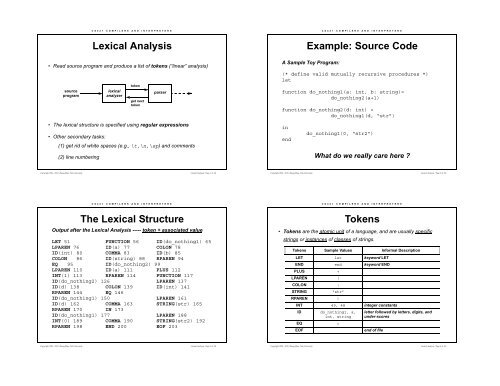
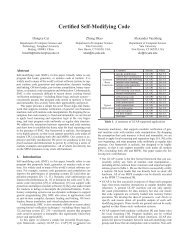
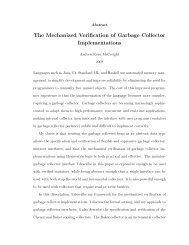
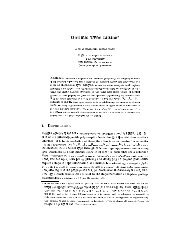
![A Tutorial on [Co-]Inductive Types in Coq - The Flint Project](https://img.yumpu.com/43409031/1/190x245/a-tutorial-on-co-inductive-types-in-coq-the-flint-project.jpg?quality=85)
